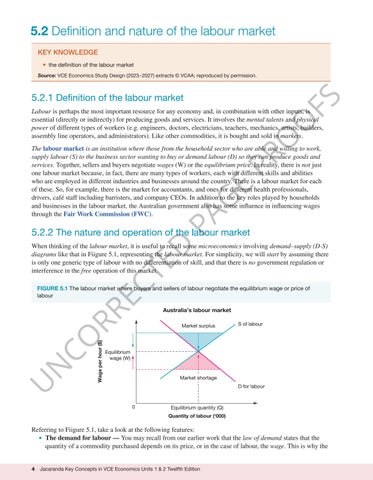“c05TheChangingLabourMarket_PrintPDF” — 2022/6/3 — 13:15 — page 4 — #4
5.2 Definition and nature of the labour market KEY KNOWLEDGE • the definition of the labour market Source: VCE Economics Study Design (2023−2027) extracts © VCAA; reproduced by permission.
FS
5.2.1 Definition of the labour market
O
O
Labour is perhaps the most important resource for any economy and, in combination with other inputs, is essential (directly or indirectly) for producing goods and services. It involves the mental talents and physical power of different types of workers (e.g. engineers, doctors, electricians, teachers, mechanics, artists, builders, assembly line operators, and administrators). Like other commodities, it is bought and sold in markets.
PA
G
E
PR
The labour market is an institution where those from the household sector who are able and willing to work, supply labour (S) to the business sector wanting to buy or demand labour (D) so they can produce goods and services. Together, sellers and buyers negotiate wages (W) or the equilibrium price. In reality, there is not just one labour market because, in fact, there are many types of workers, each with different skills and abilities who are employed in different industries and businesses around the country. There is a labour market for each of these. So, for example, there is the market for accountants, and ones for different health professionals, drivers, café staff including barristers, and company CEOs. In addition to the key roles played by households and businesses in the labour market, the Australian government also has some influence in influencing wages through the Fair Work Commission (FWC).
5.2.2 The nature and operation of the labour market
CO RR EC
TE
D
When thinking of the labour market, it is useful to recall some microeconomics involving demand–supply (D-S) diagrams like that in Fiigure 5.1, representing the labour market. For simplicity, we will start by assuming there is only one generic type of labour with no differentiation of skill, and that there is no government regulation or interference in the free operation of this market.
Wage per hour ($)
U
N
FIGURE 5.1 The labour market where buyers and sellers of labour negotiate the equilibrium wage or price of labour
Australia’s labour market Market surplus
S of labour
Equilibrium wage (W)
Market shortage D for labour
0
Equilibrium quantity (Q) Quantity of labour (‘000)
Referring to Fiigure 5.1, take a look at the following features: • The demand for labour — You may recall from our earlier work that the law of demand states that the quantity of a commodity purchased depends on its price, or in the case of labour, the wage. This is why the
4
Jacaranda Key Concepts in VCE Economics Units 1 & 2 Twelfth Edition





















































